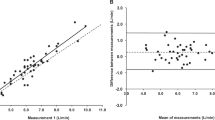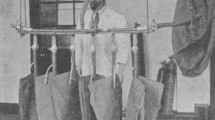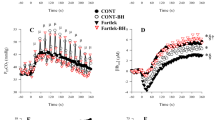Abstract
A routine method to determine total haemoglobin mass (tHb) in clinical practice and sports medicine is non-existent. Radioactive tracers or other dilution procedures like the common CO-rebreathing method (Proccom) are impractical, the latter in particular because of the relatively long time of respiration. According to the multicompartment model of Bruce and Bruce (J Appl Physiol 95:1235–1247, 2003) the respiration time can be considerably reduced by inhaling a CO-bolus instead of the commonly used gas mixture. The aim of this study was to evaluate this theoretical concept in practice. The kinetics of the HbCO formation were compared in arterialised blood sampled from an hyperaemic earlobe after inhaling a CO-bolus (Procnew) for 2 min and a CO–O2 mixture (Proccom) for ∼10 min. The reliability of Procnew was checked in three consecutive tests, and phlebotomy was used to determine the validity. VO2max was determined with and without previous application of Procnew and the half-time of HbCO was registered also in arterialised blood after resting quietly and after the VO2max test. Procnew yielded virtual identical tHb values compared to Proccom when HbCO determined 5 min after starting CO-rebreathing was used for calculation. The typical error of Procnew was 1.7%, corresponding to a limit of agreement (95%) of 3.3%. The loss of 95 g (19) haemoglobin was detected with an accuracy of 9 g (12). After application of Procnew VO2max was reduced by 3.0% (3.7) (P=0.022) and half-time was lowered from 132 min (77) to 89 min (23) after the VO2max test. Inhaling a CO-bolus markedly simplifies the CO-rebreathing method without reducing validity and reliability and can be used for routine determination of tHb for various indications.






Similar content being viewed by others
References
Arnold HR, Carrier EB, Smith HP, Whipple GH (1921) Blood volume studies. Am J Physiol 56:313–327
Ashenden MJ, Gore CJ, Dobson GP, Hahn AG (1999) Live high, train low does not change the total haemoglobin mass of male endurance athletes sleeping at a simulated altitude of 3000 m for 23 nights. Eur J Appl Physiol 80:479–484
Barker SJ (1998) Blood volume measurement. Anesthesiology 89:1310–1312
Barnett K, Wilson JF (1998) Quantitation of carboxyhaemoglobin in blood: external quality assessment of techniques. Br J Biomed Sci 55:123–126
Bland JM, Altman DG (1986) Statistical methods for assessing agreement between two methods of clinical measurement. Lancet 8476:307–310
Böning D, Rojas J, Serrato M, Ulloa C, Coy L, Mora M, Hütler M (2001) Haemoglobin mass and peak oxygen uptake in untrained and trained residents of moderate altitude. Int J Sports Med 22:1–7
Bruce EN, Bruce MC (2003) A multicompartment model of carboxyhaemoglobin and carboxymyoglobin responses to inhalation of carbon monoxide. J Appl Physiol 95:1235–1247
Burge CM, Skinner SL (1995) Determination of haemoglobin mass and blood volume with CO: evaluation and application of a method. J Appl Physiol 79:623–631
Douglas CG, Haldane JS, Haldane JBS (1912) The laws of combination of haemoglobin with carbon monoxide and oxygen. J Physiol 44:275–304
Drabkin DL (1951) Metabolism of the hemin chromoproteins. Physiol Rev 31:345–431
Ekblom B, Huot R (1972) Response to submaximal and maximal exercise at different levels of carboxyhaemoglobin. Acta Physiol Scand 86:474–482
Fogh-Andersen N, Thomsen JK, Foldager N, Siggaard-Andersen O (1990) pH effect on the COHb absorption spectrum: importance for calibration of the OSM3 and measurement of circulating haemoglobin and blood volume. Scand J Clin Lab Invest 50:247–252
Friedmann B, Jost J, Rating T, Weller E, Werle E, Eckhardt K-U, Bärtsch P, Mairläurl H (1999) Effects of iron supplement on total body haemoglobin during endurance training at moderate altitude. Int J Sports Med 20:78–85
Gibson JG, Evans WA Jr (1937) Clinical studies of the blood volume. I. Clinical application of a method employing the azo dye “Evans Blue” and the spectrophotometer. J Clin Invest 16:301–316
Godin G, Shephard RJ (1972) On the course of carbon monoxide uptake and release. Respiration 29:317–329
Gore CJ, Hahn AG, Burge CM, Telford RD (1997) VO2max and haemoglobin mass of trained athletes during high intensity training. Int J Sports Med 18:477–482
Gorelov V (2004) Theoretical value of Hüfner’s count. Anesthesia 59:97
Hauck H (1989) Parameters influencing carbon monoxide kinetics. Exp Pathol 37:170–176
He Y-L, Tanigami H, Ueyama H, Mashimo T, Yoshiya I (1998) Measurment of blood volume using indocyanine green measured with pulse-spectrophotometry: its reproducibility and reliability. Crit Care Med 26:1446–1451
Heinicke K, Wolfahrt B, Winchenbach P, Biermann B, Schmid A, Huber G, Friedmann B, Schmidt W (2001) Blood volume and haemoglobin mass in elite athletes of different disciplines. Int J Sports Med 22:504–512
Hirsch GL, Sue DY, Wasserman K, Robinson TE, Hansen JE (1985) Immediate effects of cigarette smoking on cardiorespiratory responses to exercise. J Appl Physiol 58:1975–1981
Hogan MC, Bebout DE, Gray AT, Wagner PD, West JB, Haab PE (1990) Muscle maximal O2 uptake at constant O2 delivery with and without CO in the blood. J Appl Physiol 69:830–836
Hopkins WG (2000) Measures of reliability in sports medicine and science. Sports Med 30:1–15
Horvath SM, Raven PB, Dahms TE, Gray DJ (1975) Maximal aerobic capacity at different levels of caboxyhaemoglobin. J Appl Physiol 38:300–303
Hütler M, Beneke R, Böning D (2000) Determination of circulating haemoglobin mass and related quantities by using capillary blood. Med Sci Sports Exerc 32:1024–1027
International Committee for Standardization in Haematology (1980) Recommended methods for measurement of red-cell and plasma volume: International Committee for Standardization in Haematology. J Nucl Med 21:793–800
Joels N, Pugh LGCE (1958) The carbon monoxide dissociation curve of human blood. J Physiol 142:63–77
Kisch H, Leucht S, Lichtwarck-Schoff M, Pfeiffer UJ (1995) Accuracy and reproducibility of the measurement of actively circulating blood volume with an integrated fiberoptic monitoring system. Crit Care Med 23:885–893
Klausen K, Andersen C, Nandrup S (1983) Acute effects of cigarette smoking and inhalation of carbon monoxide during maximal excercise. Eur J Appl Physiol 51:371–379
Lee RC, Wang Z, Heo M, Ross R, Janssen I, Heymsfield SB (2000) Total-body skeletal muscle mass: development and cross-validation of anthropometric prediction models. Am J Clin Nutr 72:796–803
Möller P, Sylvén C (1981) Myoglobin in human skeletal muscle. Scand J Clin Lab Invest 41:479–482
Mollison PL (1967) Blood volume. In: Mollison PL (ed) Blood transfusion in clinical medicine. Blackwell, Oxford, pp 115–150
Peterson JE, Stewart RD (1970) Absorption and elimination of carbon monoxide by inactive young men. Arch Environ Health 21:165–171
Pirnay F, Dujardin J, Deroann R, Petit JM (1971) Muscular exercise during intoxication by carbon monoxide. J Appl Physiol 31:573–575
Remington JW, Baker CH (1961) Evaluation of blood volume measurment techniques. Circ Res 9:60–68
Richardson RS, Noyszewski EA, Saltin B, Gonzáles-Alonso J (2002) Effect of mild carboxy-haemoglobin on exercising skeletal muscle: intravascular and intracellular evidence. Am J Physiol Regul Integr Comp Physiol 283:1131–1139
Sawka MN, Convertino VA, Eichner ER, Schnieder SM, Young AJ (2000) Blood volume: importance and adaptions to exercise training, environmental stresses, and trauma /sickness. Med Sci Sports Exerc 32:332–348
Shimazu T, Ikeuchi H, Sugomoto H, Goodwin CW, Mason AD, Pruitt BA (2000) Half-life of blood carboxyhaemoglobin after short-term and long-term exposure to carbon monoxide. J Trauma Inj Infect Crit Care 49:126–131
Thomsen JK, Fogh-Andersen N, Bülow K, Devantier A (1991) Blood and plasma volumes determined by carbon monoxide gas, 99mTc-labelled erythrocytes, 125 I-albumin and the T 1824 technique. Scand J Clin Lab Invest 51:185–190
Tikuisis P, Buick F, Kane DM (1987) Percent carboxyhaemoglobin in resting humans exposed repeatedly to 1,500 and 7,500 ppm CO. J Appl Physiol 63:820–827
Togores B, Bosch M, Agustí AGN (2000) The measurement of exhaled carbon monoxide is influenced by airflow obstruction. Eur Respir J 15:177–180
Tschaikowsky K, Meisner M, Durst R, Rügheimer E (1997) Blood volume determination using hydroxyethyl starch: a rapid and a simple intravenous injection method. Crit Care Med 25:599–606
Vogel JA, Gleser MA (1972) Effect of carbon monoxide on oxygen transport during exercise. J Appl Phys 32:234–239
Weaver LK, Howe S, Hopkins R, Chan KJ (2001) Carboxyhaemoglobin half-life in carbon monoxide-poisoned patients treated with 100% oxygen at atmospheric pressure. Chest 117:801–808
Acknowledgements
The project was supported by the German Federal Institute of Sports Sciences (BISp,# VF 0407/03/42). The authors wish to thank Mrs. H. Gaisser, Mr. A. Beller, Mr. A. Schmeiduch and Mr. M. Gebert for their excellent technical assistance.
Author information
Authors and Affiliations
Corresponding author
Rights and permissions
About this article
Cite this article
Schmidt, W., Prommer, N. The optimised CO-rebreathing method: a new tool to determine total haemoglobin mass routinely. Eur J Appl Physiol 95, 486–495 (2005). https://doi.org/10.1007/s00421-005-0050-3
Accepted:
Published:
Issue Date:
DOI: https://doi.org/10.1007/s00421-005-0050-3




